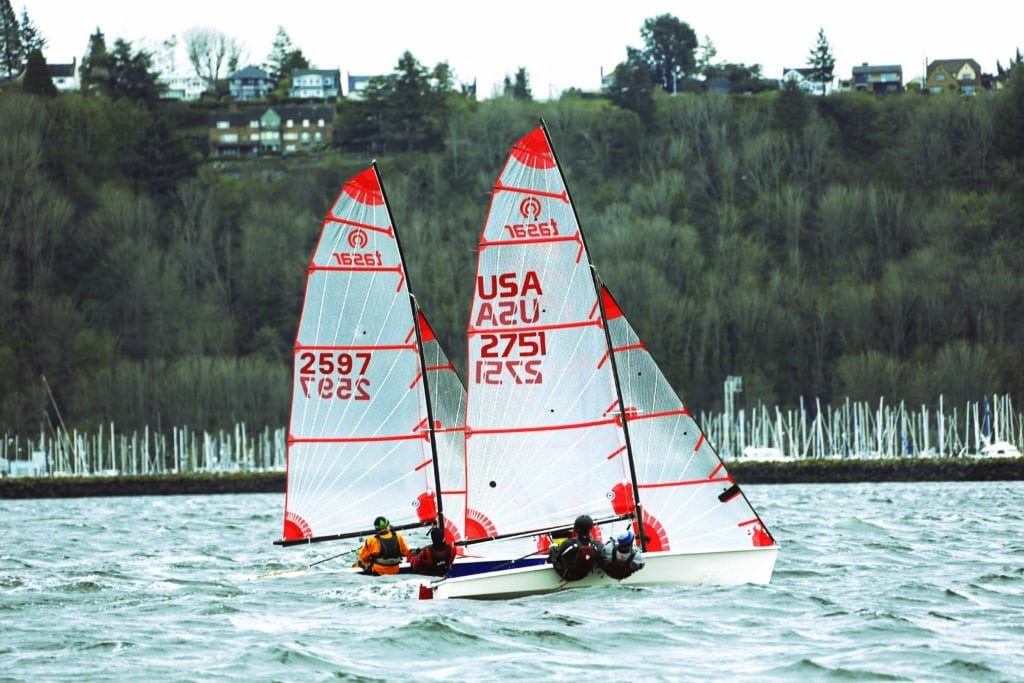
Just another 30 seconds, I tell myself, hoping I can actually keep up a full hike for that long. Libby spurs me on with a little encouragement, although I can see she is struggling too. We used to be able to do this easily. We were at the top of the heap only a few short years ago, and here we are in this very moment trying to whip ourselves back to championship form — at age 57.
I’m having my doubts.
I spent most of my early years sailing dinghies, but I’ve been primarily racing keelboats of late. I have no regrets, and I’ve learned a lot about how to win in keelboats, but in the back of my mind, I’ve held that my small-boat days are far from over. So when the opportunity to race the Tasar Worlds in Gamagori, Japan, with my wife, Libby, came up, we were both enticed, but we agreed, with some trepidation. Three other teams from Seattle were going, including our friends (of similar age) Jay and Lisa Renehan, who won the 1998 Worlds, so we’d be in good company. Still, we wondered whether we could compete against younger and fitter crews. Would our experience and cunning be enough to offset our atrophied hiking muscles?
Does any of that really matter if we can still enjoy sailing our little boat together?
Libby and I sailed a Tasar together before we were married, and for nearly 30 years since. We are one of those lucky couples who actually gets along well on a racing boat, so we’ve always enjoyed racing together. We have a lot of mutual respect, and we are both highly competitive. While there have been tense moments over the years (“Do you really see that boat on starboard?”), we always valued the sense of shared purpose that we feel when we race the Tasar together. Will this chemistry be the same when we take on this challenge now, or will frustration and a sense of lost youth spoil our experience? I don’t think so, but there’s only one way to find out.
The Tasar is a lightweight, 15-foot planing dinghy designed for couples. It has no trapeze or spinnaker, but it’s still a technically challenging and athletic boat. We’ve won three Tasar world titles, but our boat has been gathering moss over the past few years. We cleaned it off this winter and went for a few practice sails.
Our first day on the water was an eye-opener. It was light air, and we were not fast. Both of us have gotten a little heavier since the last time we raced, so that excess ballast wasn’t helping, and there were some new techniques that we needed to master. Thankfully the wind came up toward the end of our session, and we were slightly more competitive. There was a glimmer of hope, coupled with the realization that we each need to lose weight and spend more time relearning the boat. The second day of training was racing in 15 to 20 knots, a condition in which we’ve always been fast. We were true to form, at least upwind, when we could hike for more than 10 seconds at a time. Putting that extra weight to work, right? Downwind was another story; we routinely lost 200 yards on each run. So now it was clear that we needed to get back into hiking shape, and we needed to learn how to sail downwind again as well. But what a fun day on the water it was. We were hooked again.
We’ve since sailed in a variety of conditions, gradually improving. Our movements are smoother, we can hike for longer, sail trim and steering are more precise, and I am starting to figure out downwind technique (a perpetual work in progress). It feels great to noticeably improve after each sail, and at times I can sense our swagger returning. We still have a long way to go until we’re truly race-ready — especially when it comes to extended hiking — and we each still need to lose a few pounds, but we’re having fun relearning the boat we once knew so well. And how cool is it that Libby and I can (still) do this together? Enhancing our marriage while going sailing. That’s win-win, no matter what happens in Japan. ■









